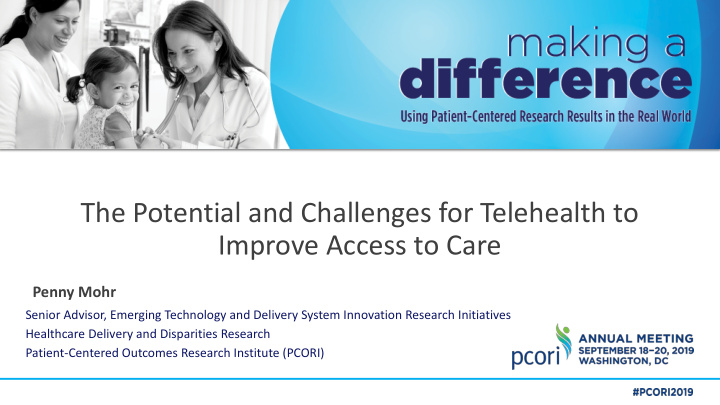



The Potential and Challenges for Telehealth to Improve Access to Care Penny Mohr Senior Advisor, Emerging Technology and Delivery System Innovation Research Initiatives Healthcare Delivery and Disparities Research Patient-Centered Outcomes Research Institute (PCORI)
Penny Mohr • Has nothing to disclose. 2
Growth in Outpatient Telehealth Services in Private Insurance Source: Harvey JB et al. Utilization of Outpatient Telehealth Services in Parity and Non-Parity States, 2010-2015. Telemedicine and eHealth 3 Published online 30 May 2018; https://doi.org/10.1089/tmj.2017.0265
Potential and Challenges for Telehealth to Improve Access to Care • Introduce panel • To learn about PCORI’s investment in telehealth research and obtain some early insights into completed results. • To provide an overview of both the potential and the challenges of using telehealth to improve access to care from the perspective of two PCORI-funded investigators. • To identify the challenges of using telehealth to improve access to care and outcomes for rural residents. • To explore what evidence is needed by payers for making coverage decisions for telehealth 4
Penny Mohr, MA Senior Advisor, Emerging Technology and Delivery System Innovation Research Session Chair Initiatives, Healthcare Delivery and Disparities Research Patient-Centered Outcomes Research Institute (PCORI) 5
Addressing Childhood Hearing Loss Susan Emmett, MD, MPH Assistant Professor of Surgery in Rural and Global Health Duke University Alaska through Telemedicine 6
Effect of a home- based exercise intervention of wearable Mary McDermott, MD technology and Jeremiah Stamler Professor of Medicine telephone Northwestern University coaching Feinberg School of Medicine on walking performance in peripheral artery disease 7
Kristine Sande, MBA Associate Director Center for Rural Health Discussant University of North Dakota School of Medicine & Health Sciences 8
Victor Yung-Tao Wu, MD, MPH Chief Medical Officer Discussant TennCare 9
PCORI’s Telehealth, Telemedicine, and mHealth Portfolio $ 381 MILLION 88 SUPPORTING COMPARATIVE CLINICAL EFFECTIVENESS RESEARCH STUDIES IN TELEHEALTH As of August 2019 Projects may be classified as more than one type 10
Number of Telehealth Projects by Primary Disease/Condition 11
Number of Telehealth Projects by Primary Disease/Condition Mental and Behavioral Health Nutritional and Metabolic Health Cardiovascular Health 12 As of August 2019
Number of Telehealth Projects by Primary Disease/Condition Cancer Rare Disease Reproductive and Perinatal Health 13 As of August 2019
Purpose of telehealth intervention • A Focus on Promoting Self-efficacy and Knowledge Framework adapted from American Telemedicine Association and Bashshur et al. The taxonomy of telemedicine. Telemedicine and eHealth. 2011 with stakeholder input. 14
Our Telehealth Projects Target Underserved Populations N=40, as of August 2019. Categories are not mutually exclusive 15
The focus is on improving patient/caregiver well being Outcome Targets for Telehealth Studies Framework adapted from: Edmunds et al. An Emergent Research and Policy Framework for Telehealth. eGems 2017; 5(2): 16 available at: An Emergent Research and Policy Framework for Telehealth
When Will Results from Telehealth Studies Likely Be Available? Average duration of telehealth projects (N=84): 3.7 years 17
Findings from Completed Studies (N=17) 18
Advancing the State of Evidence for Decisionmakers About Telehealth PCORI Stakeholder Workshop (May 24, 2018) Included 22 participants representing patients, clinicians, payers, health systems, Key message: patient/clinician experience and context are critical policymakers, and telehealth • Need to understand long-term adherence advocacy • Patient and provider experience that contributes to adoption/lack of interest and sustained use or discontinuation • Tracking use and outcomes beyond the study period • Report out contextual factors that make the telehealth component work • Type of support personnel needed • How they interact with the care team • Type of training needed • Requirements for integration with the EHR 19
Learn More • www.pcori.org • info@pcori.org • #PCORI2019 • www.YourURL.url 20
Questions? 21
Thank You! 22
Recommend
More recommend